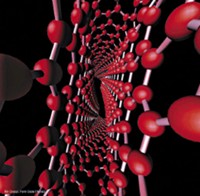Advertisement
Grab your lab coat. Let's get started
Welcome!
Welcome!
Create an account below to get 6 C&EN articles per month, receive newsletters and more - all free.
It seems this is your first time logging in online. Please enter the following information to continue.
As an ACS member you automatically get access to this site. All we need is few more details to create your reading experience.
Not you? Sign in with a different account.
Not you? Sign in with a different account.
ERROR 1
ERROR 1
ERROR 2
ERROR 2
ERROR 2
ERROR 2
ERROR 2
Password and Confirm password must match.
If you have an ACS member number, please enter it here so we can link this account to your membership. (optional)
ERROR 2
ACS values your privacy. By submitting your information, you are gaining access to C&EN and subscribing to our weekly newsletter. We use the information you provide to make your reading experience better, and we will never sell your data to third party members.
Environment
Pacing Nanotechnology
by Ivan Amato, Managing editor
July 9, 2007
| A version of this story appeared in
Volume 85, Issue 28
THE NANOTECHNOLOGY MOVEMENT has engendered an eclectic community of historians, lawyers, communicators, educators, environmentalists, and others in the science, technology, and society (STS) community who prognosticate about nanotechnology's societal implications.
A primary goal for this community is that the world will see more benefit than woe from nanotechnology. The ways they try to do this include developing educational programs about nanotechnology's promises and potential risks and publishing recommendation-filled documents aimed at regulatory agencies such as EPA and FDA.
Last month, I attended two gatherings of this community. One of them, titled "Nanotechnology & Nature: Can We Reduce Any Risks & Still Reap the Rewards," was a luncheon seminar at Resources for the Future (RFF) in Washington, D.C. The other, in Philadelphia at the Chemical Heritage Foundation (CHF), examined the roles social scientists might play in helping the public, businesses, and governments navigate the nanotechnology era. Each event offered a free lunch, yet I was fully prepared to be cynical about their value.
My predisposition to cynicism here has roots. In 1989, I attended one of the first nanotechnology meetings. It took place in Palo Alto, Calif., and was organized by a group headed by K. Eric Drexler, who then dominated the public characterization of nanotechnology. The meeting featured a fascinating mix of scientists' breathless accounts of their early steps in precisely engaging matter at the nanoscale and presentations by white-knuckled observers already worried about the dystopian futures such control over nature could make possible. That mix proved to be a microcosm of the discourse that has followed since.
Now, thousands of scientists, engineers, and STS professionals embrace the prefix "nano" in grant applications, paper titles, and names of their research centers. Governments and industries appropriate billions in nanotech R&D funding. Hardly a day passes without a nanotechnology gathering somewhere that's rife with that familiar promise-and-peril discourse.
As an observer at the RFF symposium, and as a member of a panel discussion about nanocentric communications issues at the CHF meeting, I intermittently felt waves of cynicism coming on. In 18 years of attending nano meetings, I have listened to the same anxious discussion about how society needs to manage nanotechnology before it manages us. All the while, the nanotechnologists have been sprinting. According to the Project on Emerging Nanotechnologies of the Woodrow Wilson International Center for Scholars, some 500 products with nanoscale ingredients are for sale now.
Nanotechnology, what some call "the second industrial revolution," already is unfolding as a rapidly expanding environmental and public health experiment with no new regulatory oversight in place. This is how it went with the original industrial revolution. What can advocates of a more considered, regulated approach to nanotechnology—like the organizers of the RFF and CHF gatherings—hope to achieve?
Fellow-panelist Barbara Karn, of EPA's Office of Research & Development, displaced some of my cynicism with something like gratitude. She reminded me that these meetings convene people striving to do something very hard: to help society become as adept at managing powerful technologies as it is at inventing them.
As nearly 20 years' worth of meetings demonstrate, we at least are trying to anticipate the risks nanotechnologies might pose. But we have yet to figure out how to develop prudent oversight frameworks for swiftly moving fields like nanotechnology, for which there is a dearth of data on the toxicological and environmental effects.
Even as nanoproducts stream into stores, Karn and others at the June meetings reminded me, it would be reckless to give up and leave the emergence of nanotechnology entirely in the hands of technophiles who want the future to be right now.
It is enlightened self-interest for nanotech boosters to help define the technology's potential risks and to embrace mechanisms for managing them, even if that means the future will arrive a little later.
Views expressed on this page are those of the author and not necessarily those of ACS.



Join the conversation
Contact the reporter
Submit a Letter to the Editor for publication
Engage with us on Twitter